Technology
AI Hardware Explained

Discover the specialized processors like GPUs and TPUs powering the AI revolution. Learn how this hardware makes machines smarter and faster.
What is it?
AI hardware refers to specialized computer components designed to accelerate artificial intelligence and machine learning applications. Unlike general-purpose Central Processing Units (CPUs), AI hardware is optimized for the parallel processing required by complex algorithms. Key examples include Graphics Processing Units (GPUs), originally for gaming but perfect for AI's matrix operations, and custom-built Application-Specific Integrated Circuits (ASICs) like Google's Tensor Processing Units (TPUs) and Neural Processing Units (NPUs). These chips are engineered to handle vast amounts of data simultaneously, drastically reducing the time it takes to train and run AI models.
Why is it trending?
The rise of large language models (LLMs) and generative AI has created an insatiable demand for computational power. Training models like GPT-4 requires processing trillions of data points, a task that is impractical on standard hardware. This has ignited a hardware race among tech giants like NVIDIA, AMD, and Google to create more powerful and energy-efficient chips. As AI becomes more integrated into business and consumer technology, the underlying hardware that enables it has become one of the most critical and competitive sectors in the tech industry.
How does it affect people?
Advances in AI hardware directly impact daily life by enabling more sophisticated and responsive AI services. This translates to smarter virtual assistants on phones, more realistic video game graphics, and powerful features like real-time language translation. In professional fields, it accelerates scientific discovery, from drug development to climate modeling, and enhances medical diagnostics through faster image analysis. It also fuels the development of autonomous vehicles and smarter infrastructure. The performance of the AI tools we use every day is fundamentally tied to the power and efficiency of the specialized hardware running behind the scenes.